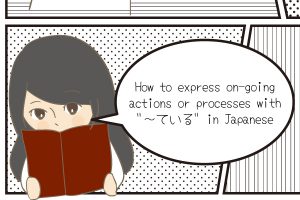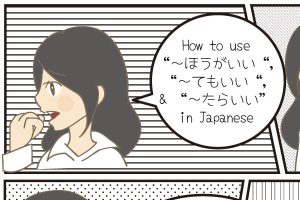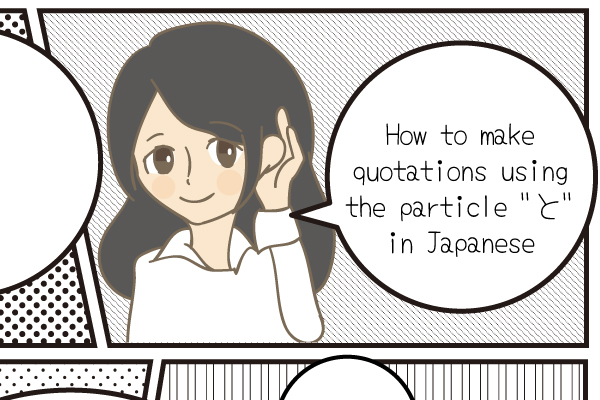How to make quotations using the particle “と” in Japanese
Last time we took a look at how to express on-going actions or lasting effects in Japanese using “~ている”. In this lesson, ou will learn how to use the particle “と” together with verbs like “言う” and “思う” to make quotations in Japanese. That way, you can express what other people told you or what you are thinking.
| Table of Contents [About “と”] [5 example sentences] |
[About “と”]
The basics of how to use the particle “と” for quotations are really easy to understand, but there are a few things to keep an eye out to use it correctly. So let’s take a closer look at the particle “と” in this article and video!
[5 example sentences]
To get all the tiny details right, let’s take a look at 5 sentences using the particle “と” to quote what somebody has said or is thinking. Take a good look at these sentences and try to figure out whether they are correct. Also try to think of why they seem correct or incorrect to you.
1. 日本語は難しいだと思います。
2. これは、あやこさんのバッグと思います。
3. けんたくんは、あそこのスーパーは安いだと言いました。
4. 友達が東京は電車が多くて便利と言っていました。
5. 先生の出身は、山形と聞きました。
What is your conclusion? Which of these sentences look correct to you?
The answer is that all of them are wrong. And this is because of how quotations work in Japanese. If you want to quote something, you will have to recite that sentence before adding the adequate ending with “と” and a verb, e.g. “~と思う” or “~と言う”.
When citing that other sentence, it must be a normal sentence, in its “普通形” which means the verb/adjective/noun used can be changed, but it must not be using the “マス形” or polite form. Let’s take apart each example to see how we can change it to its correct form!
1. x 日本語は難しいだと思います。
Let’s focus on the word “難しい”. “難しい” is an adjective. There are three types of adjectives in Japanese. Can you guess which one “難しい” is? Yes, it’s an i-adjective! So if you were to create a normal sentence using “難しい”, not using any polite or masu-form, what would that look like?
日本語は難しい。
Japanese is difficult.
As per the rule with i-adjectives, you can simply end the sentence with the adjective itself and do not need to add anything. That is important! Because this sentence is the one you will use for the quotation, adding “と” plus the adequate verb, e.g. “~と思う” or “~と言う”.
So the corrected quotation looks like this:
○ 日本語は難しいと思います。
I think Japanese is difficult.
2. x これは、あやこさんのバッグと思います。
For this sentence, let’s focus on the word “バッグ” (bag). “バッグ” is a noun, so what would this sentence look like as a normal sentence, not using the masu-form and without the quotation ending?
これはあやこさんのバッグだ。
This is Ayako’s bag.
Because it’s a noun, you have to add the verb “だ” at the end of the sentence in it’s normal, none-polite form. And that’s the point! Now all you need to do is add “~と思う” or “~と言う” to make a correct quotation:
○ これはあやこのバッグだと思います。
I think this is Ayako’s bag.
3. x けんたくんは、あそこのスーパーは安いだと言いました。
For this sentence we have to focus on the word “安い”. “安い” is an i-adjective. So it’s the same pattern as the first sentence and a normal sentence would look like this:
あそこのスーパーは安い。
That supermarket is cheap.
Now, conveying what Kenta said, the correct quotation looks like this:
○ けんたくんは、あそこのスーパーは安いと言いました。
Kenta said that supermarket was cheap.
4. x 友達が東京は電車が多くて便利と言っていました。
To get this right we have to look at “便利”. “便利” is a na-adjective, so different from an i-adjective, you do actually have to add “だ” when creating a normal sentence using a na-adjective. So the friend could have said:
東京は電車が多くて便利だ。
Tokyo is convenient because it has many trains.
It’s just like sentence pattern 2 using a noun. Now, the correct quotation would look like this:
○ 友達が東京は電車が多くて便利だと言っていました。
My friend was saying that Tokyo is convenient because it has many trains.
5. x 先生の出身は、山形と聞きました。
First of all, let’s focus on the verb “聞く” (to hear)/“聞きました” (I heard) here. This is not a direct quotation, but rather conveying a rumour or hearsay someone has picked up and is telling another person. It’s different from the “引用” (quotation) we are studying today, but since it can be used exactly the same way with “と” we are mentioning it here.
So, let’s focus on the word “山形”. Yamagata is a city as well as prefecture in Japan – therefore it is a noun! Now, when creating a normal sentence with a noun… right, we need to add “だ”! So, what the person conveying the hearsay actually heard must be something along the lines of:
先生の出身は、山形だ。
The teacher’s birthplace is Yamagata.
So in conveying what this person heard from person A to person B, the correct form is:
○ 先生の出身は、山形だと聞きました。
I heard that teacher’s birthplace is Yamagata.
Whether you put the “だ” in front of “~思う”, “言う”, or for rumours/hearsay “~聞く” may seem like a small thing to you, but if you want to speak clear and correct Japanese, you have to figure out whether you need it or not first.
But as long as you can create the proper normal sentence first, you should have no problem deducting the correct grammar!
Getting it right in conversation may require a lot of practice, so don’t worry about making mistakes, but be aware of them and try to fix them where possible!
As always, don’t forget to check out the video on this class and tune in to our livestream every wednesday at 6pm (JST) for the real deal!
| 引用 | Reason |
| 理由 | Progress |
| 正解 | Correct answer |
| 確認する | To check, to confirm |
| 正しい | Correct |
| 直す | To correct, to cure, to fix |
| 注目する | To focus, to pay attention |

How to express on-going actions with “~ている” in Japanese

How to use “~ほうがいい”, “~てもいい”, & “~たらいい” in Japanese



